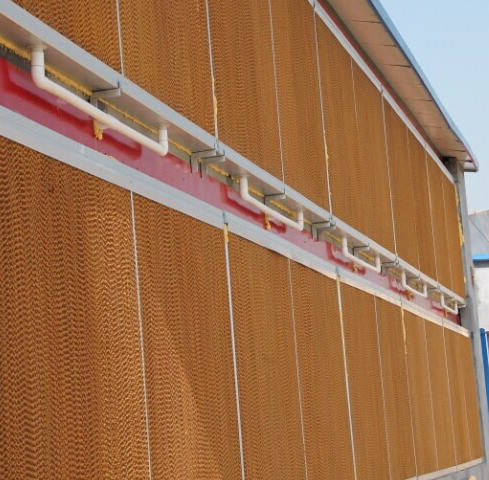Agriculture has always been susceptible to environmental factors, with temperature being a critical element influencing crop growth. In recent times, innovative methods such as water curtain wall cooling systems have emerged as a solution to regulate temperatures and enhance crop cultivation. This article delves into the suitability of water curtain wall cooling systems for various crops and farming environments.

Overview of Water Curtain Wall Cooling Systems
Water curtain wall cooling systems are designed to regulate temperature by creating a barrier of water droplets through which air passes. This process facilitates evaporative cooling, lowering the surrounding temperature. The system comprises pumps, pipes, and nozzles that release fine water droplets, providing a cooling effect when these droplets absorb heat from the air.
Factors Influencing Crop Suitability
The suitability of water curtain wall cooling systems for crops is significantly influenced by various environmental, physiological, and agricultural factors. Understanding these factors is crucial in determining the efficacy of these systems in different farming scenarios.
- Environmental Factors
Temperature Extremes: Elevated temperatures pose a significant challenge to many crops, especially during the hot seasons or in regions characterized by high ambient temperatures. Heat stress can disrupt essential physiological processes in plants, leading to reduced photosynthesis, impaired nutrient uptake, and compromised yield.
Humidity Levels: The effectiveness of evaporative cooling, the principle mechanism behind water curtain wall systems, is influenced by humidity. Higher humidity levels can limit the cooling effect, affecting the system’s efficiency in moderating temperatures.
Solar Radiation: Intense sunlight can exacerbate heat stress on crops. Water curtain wall systems may be more beneficial in areas with excessive solar radiation, as they provide shade and reduce direct exposure to sunlight.
- Crop Sensitivity
Heat-Sensitive Crops: Certain crops are inherently more susceptible to high temperatures. Leafy greens like lettuce and spinach, as well as fruits like strawberries and tomatoes, are highly sensitive to heat stress. Maintaining optimal temperatures is critical for their growth, development, and overall quality.
Crop Growth Stage: The susceptibility of crops to heat stress varies at different growth stages. For instance, flowering and fruiting stages are particularly sensitive periods when temperature stress can significantly impact yield and fruit quality.
- Agricultural Practices
Crop Diversity and Rotation: Farms cultivating a diverse range of crops may find water curtain wall systems advantageous as they can accommodate the varying temperature requirements of different crops. Rotation systems might benefit from these cooling systems by ensuring consistent and favorable growing conditions for a variety of crops throughout the year.
Location and Farm Size: The geographical location of a farm and its size can influence the feasibility and scalability of implementing water curtain wall cooling systems. Large-scale operations or farms located in areas prone to extreme temperatures may find greater value in investing in these systems.
- Technological Adaptation
System Adaptability and Customization: The adaptability of water curtain wall systems to different agricultural settings, whether in greenhouses or open fields, determines their suitability. Tailoring these systems to meet specific crop needs and environmental conditions enhances their effectiveness.
Maintenance and Operational Costs: Alongside installation expenses, the ongoing maintenance and operational costs of these systems are crucial considerations. Evaluating the long-term benefits against the costs involved is essential for farmers considering the implementation of cooling systems.
Understanding these multifaceted factors is fundamental for farmers and agricultural practitioners in deciding the appropriateness and effectiveness of utilizing water curtain wall cooling systems for their crops. Adapting these systems to suit specific crop requirements and environmental conditions is pivotal for maximizing their benefits and ensuring sustainable agricultural practices.
Crops Benefiting from Water Curtain Wall Cooling Systems
- Heat-Sensitive Crops: Certain crops are highly responsive to temperature changes. For instance, leafy greens such as lettuce and spinach thrive in cooler environments. Using water curtain wall cooling systems in greenhouses or open fields can optimize their growth conditions.
- High-Value Crops: Cultivation of high-value crops like berries, tomatoes, and certain herbs demands precise temperature control. These crops are not only sensitive to heat but also command premium prices in the market. Employing cooling systems ensures optimal conditions for their growth, thereby maintaining their quality and market value.
- Region-Specific Crops: Agriculture in regions with high temperatures or extreme climatic conditions greatly benefits from cooling systems. Crops grown in arid or semi-arid areas, where temperature fluctuations are drastic, require consistent cooling measures to mitigate the impact of heat stress.
Farming Environments Ideal for Water Curtain Wall Cooling Systems
- Greenhouses and Controlled Environments: Water curtain wall systems are highly effective in greenhouses where environmental control is paramount. These systems maintain stable temperatures, creating an ideal microclimate for crops regardless of external weather conditions.
- Open-Field Farming in Hot Climates: In regions with high temperatures, such as subtropical or tropical areas, implementing cooling systems in open-field farming can significantly improve crop yields. By reducing heat stress, farmers can cultivate a wider range of crops effectively.
- Specific Geographical Areas: Certain geographical locations witness temperature fluctuations or heatwaves. Implementing cooling systems in these areas can offer relief to crops during intense heat periods, ensuring steady growth and yield.
Advantages and Limitations of Water Curtain Wall Cooling Systems
Water curtain wall cooling systems offer several advantages, including:
- Enhanced crop growth and yield
- Improved crop quality and market value
- Reduced heat stress-related crop losses
- However, these systems also have limitations, such as initial setup costs, maintenance requirements, and effectiveness being influenced by external factors like humidity levels.
Conclusión
In conclusion, water curtain wall cooling systems play a pivotal role in agriculture by mitigating the adverse effects of high temperatures on crop growth. They are particularly beneficial for heat-sensitive, high-value crops and in regions experiencing extreme temperatures. Despite some limitations, the advantages in optimizing crop productivity and quality make these systems an invaluable asset for modern agricultural practices.
Through a tailored approach considering crop sensitivity and environmental conditions, the implementation of water curtain wall cooling systems demonstrates a promising avenue in the quest for sustainable and efficient agricultural practices.
Productos relacionados





